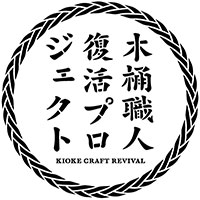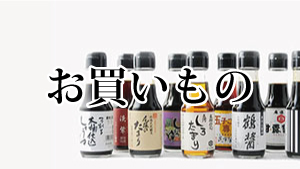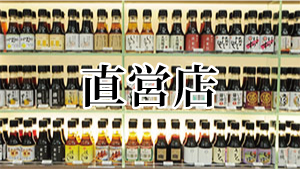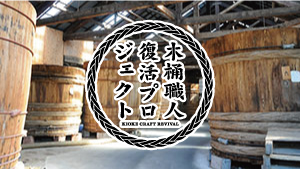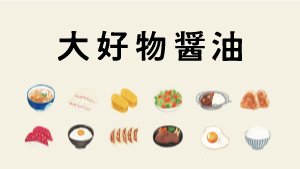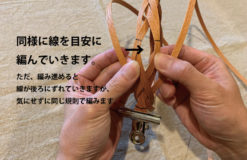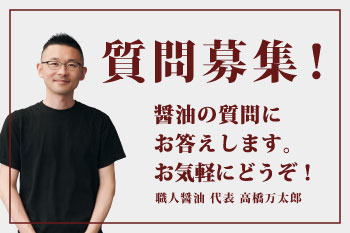木桶仕込みの蔵
岡本醤油醸造場│Okamoto
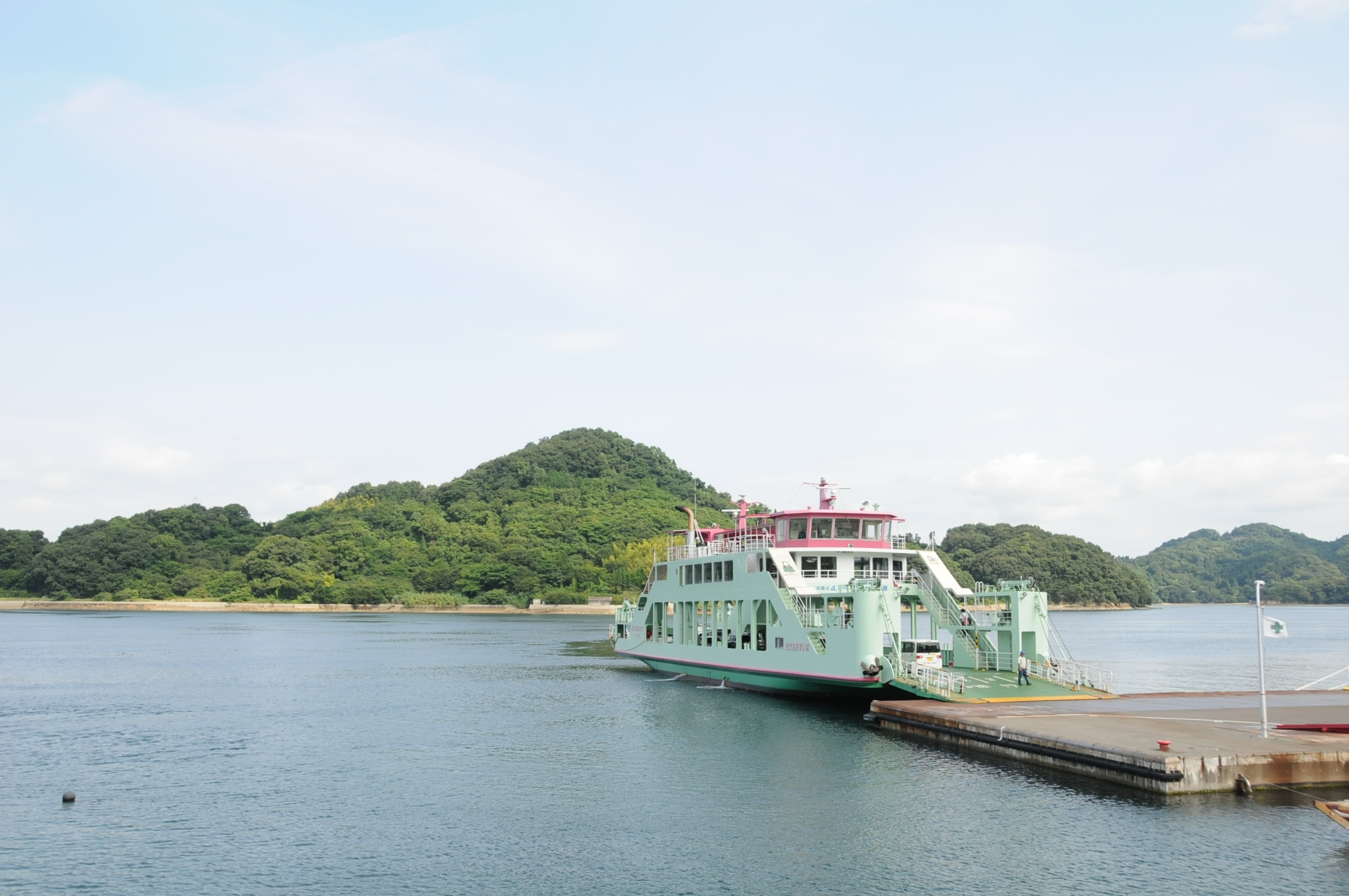
醤油づくりをこよなく愛する
醤油づくりを最も愛しているつくり手、そう聞かれたら岡本さんの名前をあげたいです。ただ、広島県といっても大崎上島はフェリーでしか行けません。昔は島観光のついでに醤油蔵見学に立ち寄られる方もいたそうですが、今では岡本醤油を目指してフェリーに乗る方が多くなってきているそうです。
A deep love for making soy sauce
When I think of someone who has a great love for making soy sauce, I think of Yoshihiro Okamoto. Although the location of the brewery is in Hiroshima Prefecture, Osakikamijima is in fact an island, which is only accessible by ferry. In the past, island tours would stop by the soy sauce brewery as one of the attractions. But now, people make the journey from all over just for Okamoto’s soy sauce.

瀬戸内海のへそで造られた醤油
広島県の竹原からフェリーで30分。大崎上島町は造船とみかん栽培で盛んな島。この瀬戸内海に浮かぶ人口約9,000人の島に、とっても素敵な醤油蔵があります。
厳選した国内産大豆と普通小麦、天日塩のみを原料に、昔ながらの杉の大桶で造られた醤油は、もちろん天然醸造。30本ある桶の中の醤油たちは、毎日、岡本さんたちに見守られながら熟成の時を過ごしています。
Brewing soy sauce in the center of the Seto Inland Sea
30 minutes by ferry from Takehara Port in Hiroshima Prefecture, Osakikamijima is an island active in shipbuilding and mandarin orange growing. On the island of 9,000 people, there is a lovely soy sauce brewery.
Carefully selected domestic soybeans, wheat, and sun−dried salt, all are naturally−brewed in traditional kioke(a large wooden barrel made of Japanese cedar). Every day, Okamoto watches over the 30 kioke, full of delicious soy sauce, as they mature and ferment.

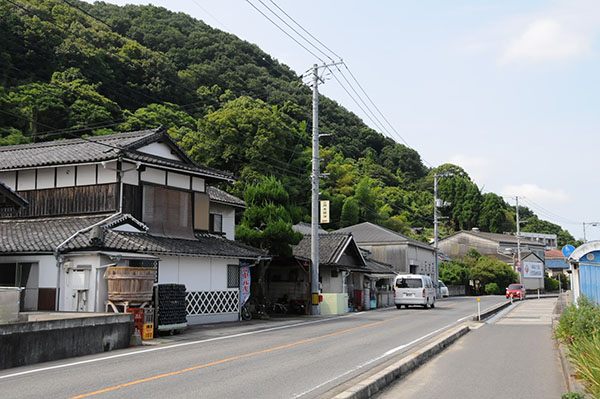
最高のもてなしって・・・
2008年の原油高の時期に原料も資材も値上がりをし、多くの醤油メーカーは価格を一斉に上げました。ただ、岡本さんは値上げをしなかったそうです。「商売っ気がないっていわれればその通りかもしれないですけどね・・・ただ、醤油を大切に使っていただきたいんですよ!」そして、「できるだけ手間と時間をかけて料理をしていただきたいですね・・・」と岡本さん。
最近は加工品の「つゆ」を使われる方も多くなっていると思います。ただ、例えば、お客様をもてなすときに、「夏の暑い時期は塩分を少し多めに、寒い時期は少し甘みを強くして・・・とその季節、お客様に応じた対応をすることって、最高のもてなしだと思うんです。」
こういった考え方が、岡本さんの醤油づくりのベースになっているので、お話の中にも「自然」や「美味しい醤油」というキーワードがたくさん出てきます。「畑から出来た大豆と小麦に、海のエキスが凝縮されている塩。これらが原料となって日本の四季の中で麹菌をはじめとした微生物の力で発酵・熟成させたのが醤油なんです。」
The best hospitality
During the period of high crude oil prices in 2008, the cost of raw materials rose, causing many soy sauce breweries to simultaneously increase their soy sauce prices. However, Okamoto did not raise his prices: “Although there was little to no business interest at the time, I wanted my soy sauce to be enjoyed and used with great care. So that’s why I used all my effort and time to make good soy sauce,” said Okamoto.
Recently, there are many breweries using “tsuyu” or “processed broth” in their soy sauce, and they would keep the same recipe for the whole year. But Okamoto tries to accommodate his customers’ needs: “When it’s hot in the summer, I add a little bit more salt to the soy sauce. When it’s cold in the winter, I add a little bit of sugar to the soy sauce. I think that is the best hospitality—to be able to satisfy our customers.”
Because these ideas are the foundation of Okamoto’s soy sauce, he uses many keywords such as “nature” and “delicious soy sauce” when describing his products. Okamoto says, “Soybeans and wheat from the field, mixed with the salt from the sea. These raw materials turn into valuable koji (naturally−occurring mold grown on beans), and through the power of microorganisms that originated from Japan’s four seasons, the soy sauce is fermented.”
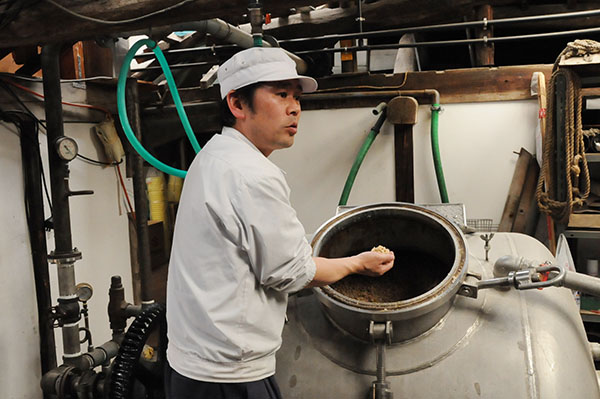

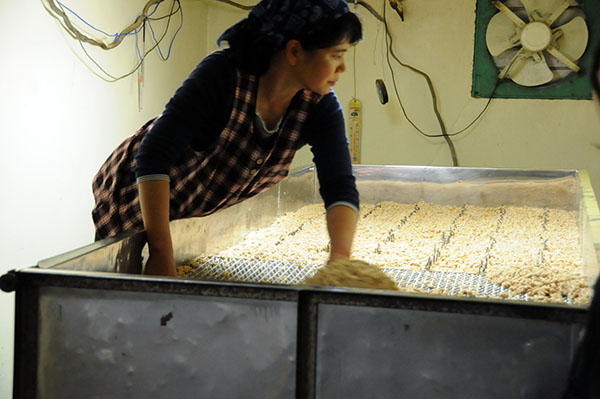

家庭料理のための醤油を造ろうと
蔵を継いだばかりの頃は、他の醤油屋もこぞって家庭に醤油を配達していたそうです。「『選ばれなきゃ!』、『使って欲しい!』と思いながら配達をしていると、料理している家から香りがしてきて『うちの醤油の香りだ!』とわかるのです」。
この家では煮しめに、あの家では煮魚にと、味わいやアレンジの仕方が家によって少しずつ違っている光景を感じたそうです。その時に思った「家庭料理」が醤油づくりのベースになっているといいます。
「帰って来た頃は若かったからいろいろ珍しい醤油を造りたいと思っていたけど、家庭を巡って思ったんだ。どの家庭で使っても美味しく楽しめる醤油がいいって。醤油の味もぶれてはいけない。冬の根、春の菜、夏の茎、秋の実もおいしくする醤油を造ろうって」そう話す岡本さんの声は暖かい。
Making soy sauce for home cooking
When Okamoto had just inherited the brewery, he noticed that other shops would deliver the soy sauce to families across the island. He wanted to have his soy sauce to be chosen and used too, so he also delivered his soy sauce. After some time, as he was passing by some of the houses, there was a familiar fragrance in the air—it was his own soy sauce that people would use for cooking!
Okamoto realized that one house will cook vegetables this way, and another house will cook fish a different way. Each cooking style and taste is slightly different depending on the house. And since that time, he realized that “home cooking” is the base of soy sauce−making.
“When I was young, I wanted to make a variety of unique soy sauces, but then I thought about my family—it’s better to make delicious soy sauce that you can use at any home. I didn’t want to veer too far off from the original flavor of soy sauce. Winter roots, spring vegetables, summer stalks, and autumn fruit, each are the best harvest of every season. I want to bring out these flavors in my soy sauce,” said Okamoto in a warm voice.
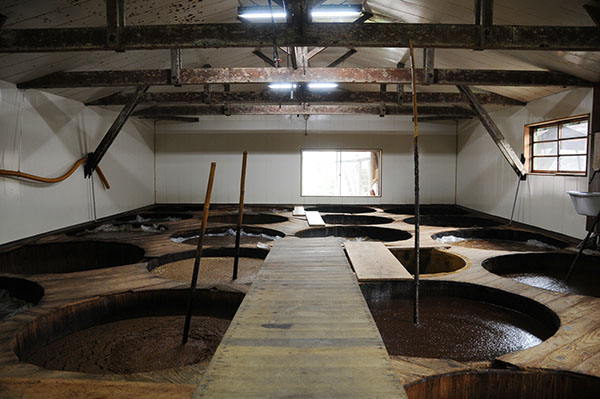


30本の桶が精一杯なんよ・・・
昔ながらの醤油づくりをしている蔵では大量生産できないと言われますが、それは当然なのです。
蔵を取り巻く自然環境や、蔵に住み着く微生物たちの性格にもよるのですが、醤油の元になる諸味を熟成させる時、人が手をかけずにいると「産膜酵母」と呼ばれる白カビが発生してしまいます。当然、醤油にとって悪い影響を与える存在なのですが・・・
その白カビを防ぐ手立てとして攪拌(かくはん)があります。桶の中の諸味(もろみ)をかき混ぜるのですが、この作業がとっても大変。20石の桶だと容量は約3,600リットル。3トン以上の重さを、攪棒(かいぼう *上写真の棒)を使って手作業でかき混ぜるのです。どれほど大変かは容易に想像いただけると思いますが、この作業を3日毎に行うわけです。それも30本の桶全て!
30 kioke is the best one can manage
Naturally, traditionally-made soy sauce cannot be mass−produced.
Depending on the natural surroundings where the brewery is located, and the nature of the microorganisms that live in the brewery, these factors will affect how the moromi is matured. Moromi is the key element that gives each soy sauce brewery its unique taste. If people touch the moromi or kioke, then a type of white mold called “film yeast” will appear, negatively affecting the soy sauce.
Fortunately, stirring the moromi will prevent the white mold from appearing, but it is laborious work. With a 20 stone kioke (about 3,600 liters or 792 gallons) that weighs more than three tons, stirring by hand is no small task. Every three days, Okamoto stirs all 30 kioke by himself!


風の通り抜ける蔵
一般的に、醤油づくりは水を使えば、カビの一種である麹菌も使います。しかも、長い時間をかけて熟成させますので、蔵自体も湿気がたまりやすく、カビが発生してイヤな匂いがすることもあります・・・
ただ、岡本さんの蔵は違うんです。醤油の良い香りが広がっています!どうしてだろう?!と考えてみると、それは掃除と整理整頓が行き届いていることと、自然の風が通り抜ける道が出来ているからなのかなと・・・
渡り廊下の奥は山々が広がり、手前には瀬戸内海の海が広がっています。山の木々が光合成をして酸素をいっぱいに含んだ風と、海のミネラルをたっぷり含んだ風が常に通り抜けているのです。これらの風が蔵の中の隅々まで循環しています。常に自然な空気が余分な湿気を運んでいってくれ、新鮮な状態を保っています。
Wind passing through the brewery
Generally, if you use water to make soy sauce, then naturally−occurring mold called koji is used. As the koji matures over time, the warehouse will easily accumulate moisture, which may cause an unpleasant odor.
But Okamoto’s brewery is different. His soy sauce’s fragrant aroma spreads near and far. Why is that? With thorough cleaning and organization of the brewery, along with the natural wind that passes through, this allows the aroma to spread.
With the mountains behind the brewery and the Seto Inland Sea in front, it becomes a natural air freshener. The trees up on the mountainside contain an abundance of oxygen, whereas the ocean wind has an abundance of natural minerals. The mountain and ocean breezes are constantly passing through, circulating to every corner in the brewery. The natural air carries the perfect amount of moisture, and always keeps the brewery in crisp condition.



搾り場の丁寧さ
ドアをあけて圧搾場の中に入るとアルコールの香りに包まれます。「うわぁっ!すごいですね」と口にしてしまう程、しっかりと酵母菌が活躍してくれた証拠です。そして印象的だったのが、何十枚と積み重ねられている風呂敷がきれいに揃っていることでした。
風呂敷を広げて、諸味を入れて包み込むと、1枚の座布団のような状態になります。これを何十枚と積み重ねていくのですが、均等にするには諸味の量と厚みを揃える必要があります。これがなかなか難しく、几帳面な人とガサツな人の性格が明確に反映されてしまう程です。
じーっと作業を見学させていただくと、ゆっくり丁寧に、そして右手で諸味を触りながら平らに均しています。「微妙な凹凸は手で触らないと分からないもので・・・」と控えめに説明してくれましたが、この配慮と文字通りひと手間かけるスタンスが、やっぱり岡本さんの醤油らしいなと感じてしまいました。
Careful pressing
When you open the door and enter into the pressing and refining room, you will be surrounded by the smell of alcohol. This becomes proof that the yeast fungus is active and flourishing. What is also impressive is seeing the dozens of furoshiki, or “cloth wrapper,” all neatly stacked.
Unraveling the furoshiki,the moromi will be carefully wrapped in the furoshiki,and will look like a cushion.A person will stack dozens of the wrapped moromi sheets together. But in order to be flat and even throughout, a person would need to align the proper amount of the moromi in each sheet. This is a difficult task, so a person must have an eye of precision, and must be able to roughly calculate the appropriate supply of moromi in each sheet.
By slowly and carefully patting the moromi, it will even out. One of the employees that works with the moromi said, “I can’t tell if there are any subtle irregularities until I touch the moromi with my hand.” After hearing that, this type of work is extremely time−consuming. But after all, this is Okamoto’s soy sauce.


岡本さんの醤油愛が伝わってきます
価格 : 362円+税
原材料 : 大豆、小麦、食塩

岡本さんの醤油愛が伝わってきます
価格 : 428円+税
原材料 : 大豆、小麦、食塩、アルコール

